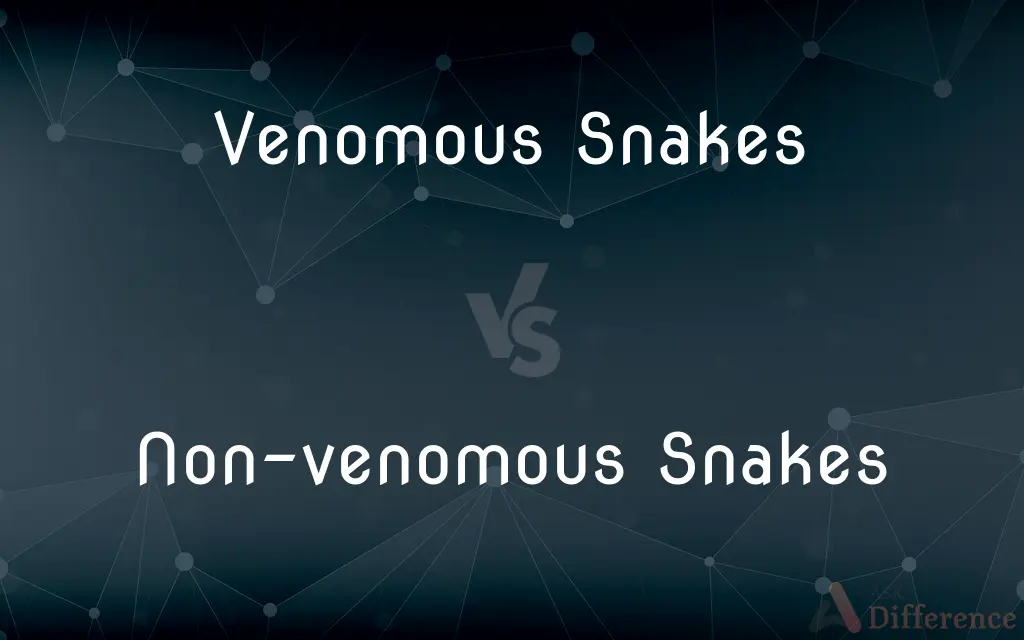Venomous Snakes vs. Non-venomous Snakes — What's the Difference?
By Tayyaba Rehman — Published on December 15, 2023
Venomous snakes produce toxins to immobilize prey and defend against predators, while non-venomous snakes don't.

Difference Between Venomous Snakes and Non-venomous Snakes
Table of Contents
ADVERTISEMENT
Key Differences
Venomous snakes possess specialized glands that produce venom, a potent concoction of toxins. In contrast, non-venomous snakes lack these glands and do not produce venom.
While venomous snakes use their venom to paralyze or kill their prey and deter threats, non-venomous snakes employ other strategies, such as constriction, to subdue their meals.
In terms of appearance, some venomous snakes may have distinct features like heat pits and elliptical pupils. However, non-venomous snakes might not have these particular traits.
Venomous snakes often pose a threat to humans if bitten due to their venom's toxic effects. On the other hand, bites from non-venomous snakes are generally harmless barring potential infections or allergic reactions.
Despite the potential danger of venomous snakes, they play a crucial role in regulating pest populations. Similarly, non-venomous snakes are vital to their ecosystems, helping to control prey numbers.
ADVERTISEMENT
Comparison Chart
Venom Production
Have glands that produce venom
Do not produce venom
Predation Strategy
Use venom to paralyze or kill prey
Use constriction or other methods
Potential Threat to Humans
Bites can be lethal due to venom
Bites are generally not toxic
Common Physical Traits
May have heat pits and elliptical pupils
Often lack these specific traits
Role in Ecosystem
Control pest populations through venomous predation
Regulate prey numbers without using venom
Compare with Definitions
Venomous Snakes
Venomous snakes use their venom both as a defense mechanism and a hunting tool.
Some venomous snakes can even spit their venom to deter potential threats.
Non-venomous Snakes
Non-venomous snakes, despite not having venom, can still bite when threatened.
While hiking, one might encounter a non-venomous snake sunbathing on a trail.
Venomous Snakes
Venomous snakes are reptiles that secrete toxins to immobilize their prey.
Rattlesnakes are a type of venomous snake found in the Americas.
Non-venomous Snakes
Non-venomous snakes pose minimal threat to humans as they lack venom.
Garden snakes are non-venomous and often seen in backyard habitats.
Venomous Snakes
Venomous snakes are often identifiable by certain physical features, although not always.
The cobra is a venomous snake recognizable by its hood.
Non-venomous Snakes
Non-venomous snakes are reptiles that don't produce venom and rely on other methods to catch prey.
The python is a non-venomous snake that constricts its prey.
Venomous Snakes
Venomous snakes are diverse, found in various habitats around the world.
The tropical rainforests house a variety of venomous snakes.
Non-venomous Snakes
Non-venomous snakes are just as important to biodiversity as their venomous counterparts.
Corn snakes, non-venomous by nature, are popular pets due to their docile temperament.
Venomous Snakes
Venomous snakes can pose a threat to humans if provoked or accidentally stepped on.
Many victims are bitten by venomous snakes when trying to handle them.
Non-venomous Snakes
Non-venomous snakes can be found in diverse habitats and play a role in their ecosystems.
Garter snakes, which are non-venomous, help control pest populations.
Common Curiosities
Are non-venomous snakes harmless?
Generally, yes, but they can still bite if threatened.
Can you identify venomous snakes by their pupils?
Some venomous snakes have elliptical pupils, but this isn't a definitive rule.
How do non-venomous snakes eat?
They use methods like constriction or swallowing prey whole.
Are non-venomous snake bites painful?
They can be, due to the bite itself, but lack the toxic effects of venom.
What are venomous snakes?
They are snakes that produce venom, a toxic substance.
Why do venomous snakes produce venom?
Primarily for predation and self-defense.
How many species of venomous snakes exist?
There are around 600 known venomous snake species.
Do all venomous snakes have fangs?
Most do, but the type and position of fangs vary.
Can non-venomous snakes climb trees?
Many species, like rat snakes, are excellent climbers.
Do non-venomous snakes have teeth?
Yes, they have teeth but lack venomous fangs.
Can non-venomous snakes mimic venomous ones?
Some species mimic venomous snakes to deter predators.
Are venomous snake bites always fatal to humans?
Not always, but seeking immediate medical attention is crucial.
How do you treat a venomous snake bite?
Seek medical attention immediately and keep the affected limb immobilized.
Do non-venomous snakes play a role in their ecosystems?
Yes, they help control prey numbers and are prey for larger predators.
Can venomous snakes control when they release venom?
Yes, some snakes can deliver a "dry bite" without releasing venom.
Share Your Discovery

Previous Comparison
Arithmetic Sequence vs. Geometric Sequence
Next Comparison
Sagittal Plane vs. Coronal PlaneAuthor Spotlight
Written by
Tayyaba RehmanTayyaba Rehman is a distinguished writer, currently serving as a primary contributor to askdifference.com. As a researcher in semantics and etymology, Tayyaba's passion for the complexity of languages and their distinctions has found a perfect home on the platform. Tayyaba delves into the intricacies of language, distinguishing between commonly confused words and phrases, thereby providing clarity for readers worldwide.
















































